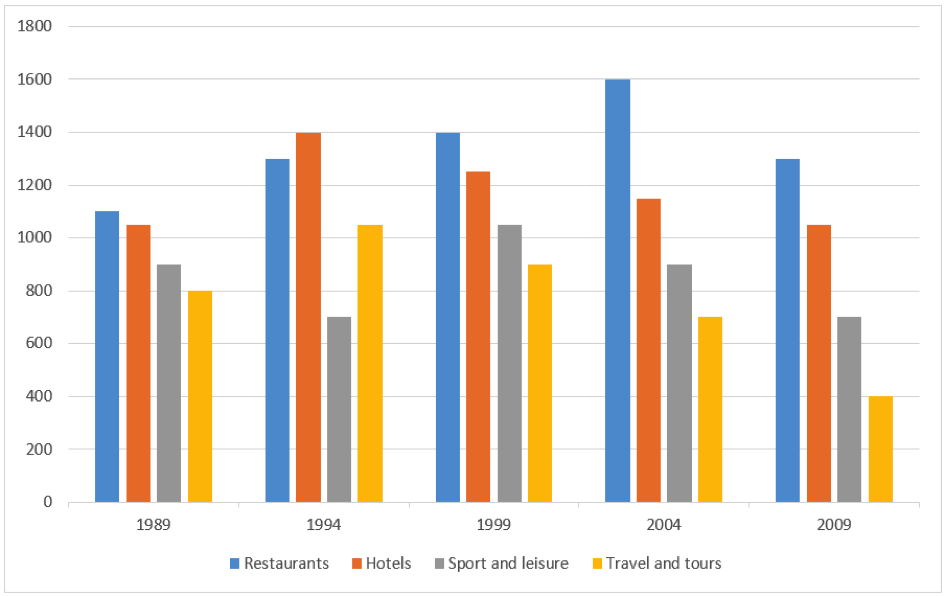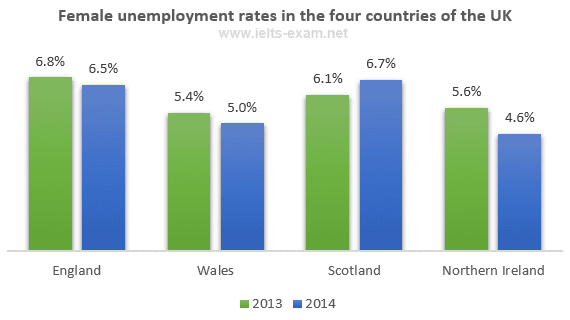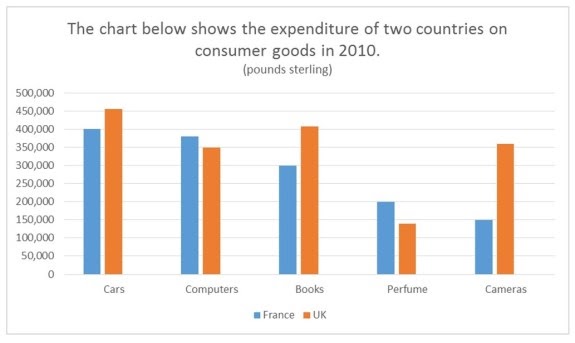Dạng bài Bar Chart là một trong những dạng bài thường xuất hiện và dễ viết nhất ở phần thi IELTS Writing Task 1 trong bài thi IELTS. Có rất nhiều cách để mô tả loại biểu đồ này, trong bài viết này ieltscaptoc.com.vn sẽ chia sẻ cho bạn cách làm bài bar chart chuẩn và dễ dàng nhất. Hãy cùng theo dõi nhé!

Nội dung chính
Dạng 1: Bar Chart có sự thay đổi theo thời gian
1. Introduction
Để viết được một phần mở bài đầy đủ, trước hết chúng ta cần xác định được những thông tin sau trong đề bài:
- Topic (Chủ đề của biểu đồ)
- Place (Nơi chốn)
- Time span (Thời gian)
- Unit of measurement (Đơn vị đo)
Ví dụ: The bar chart shows the different modes of transport used to travel to and from work in one European city in 1960, 1980 and 2000
- Chủ đề: female unemployment rates
- Nơi chốn: each country of the United Kingdom
- Khoảng thời gian: năm 2013 và 2014
- Đơn vị đo lường: phần trăm (%)
Sau khi đã xác định xong các yếu tố trên, chúng ta sẽ paraphrase lại để bài bằng cách sử dụng từ đồng nghĩa hoặc thay đổi cấu trúc ngữ pháp
The bar chart illustrates the percentage of jobless women in 4 different countries in Britain in 2013 and 2014
| Từ trong đề bài | Từ đồng nghĩa |
| The graph | The bar chart |
| shows | illustrates |
| female unemployment rates | the percentage of jobless women |
| each country of the united kingdom | 4 different countries in britain |
2. General Overview
Trong phần Overview, chúng ta nên quan tâm đến những đặc điểm nối bật bằng cách
- So sánh điểm đầu và điểm cuối của các đối tượng được so sánh để phát hiện chúng tăng, giảm hay giữ nguyên
- So sánh đối tượng đó với các đối tượng còn lại trong đề bài để xác định được đối tượng nào có số liệu nổi bật và ít nổi bật nhất

Từ hình trên, chúng ta có thể nhận thấy rằng:
- Phần trăm phụ nữ thất nghiệp ở England,Wales và Northern Ireland giảm
- Phần trăm phụ nữ thất nghiệp ở Scotland tăng
- Tỷ lệ thất nghiệp ở nữ giới của England và Scotland cao hơn hai nước còn lại
Từ đó, ta có phần overview như sau:
Looking at the graph, it is readily apparent that England, while Wales and Northern Ireland successfully decreased the unemployment rates among women, the figure for Scotland showed an upward trend. It is also of note that the unemployment rates of English women and Scottish women were remarkably higher than those in Wales and Northern Ireland.
3. Body
Cách tổ chức thông tin
- Đoạn body 1 nói về số liệu của năm 2013
- Đoạn body 2 nói về số liệu của năm 2014
- Bên cạnh đó, cần dùng các từ nối để liên kết các câu và làm nổi bật sự giống nhau hoặc tương phản của số liệu
| OUTLINE |
| BODY 1: Số liệu của năm 2013Cao nhất: England (6.8%)Cao thứ hai: Scotland (6.1%)Hai nước có số liệu gần bằng nhau: Northern Ireland và Wales (5.4% và 5.6%) |
| BODY 2: Số liệu của năm 2014Cao nhất: Scotland (Tăng đến 6.7%)Xu hướng đối nghịch: Wales và Northern Ireland (giảm còn 5.0% và 4.6%)Xu hướng tương tự: England (cũng giảm còn 6.5%) |
Từ outline trên, ta viết thành hai đoạn thân bài như sau:
In 2013, the percentage of unemployed women in England stood at 6.8%, followed by Scotland at 6.1%. Meanwhile, the proportion of women who were out of work in Northern Ireland and Wales was relatively similar, with respective figures being 5.4% and 5.6%.
A year later, the rate of unemployed women in Scotland experienced a slight increase to 6.7%, making it the highest figure in the year 2014. Such a trend was not seen in the figure for their counterparts in Wales and Northern Ireland, which went down to 4.6% and 5.0% respectively. Similarly, England also witnessed an insignificant drop, although to a larger extent, to 6.5% in the unemployment rate.
Sample hoàn chỉnh:
The bar chart gives information about the percentage of jobless women in 4 different countries in Britain in 2013 and 2014
Looking at the graph, it is readily apparent that England, while Wales and Northern Ireland successfully decreased the unemployment rates among women, the figure for Scotland showed an upward trend. It is also of note that the unemployment rates of English women and Scottish women were remarkably higher than those in Wales and Northern Ireland.
In 2013, the percentage of unemployed women in England stood at 6.8%, followed by Scotland at 6.1%. Meanwhile, the proportion of women who were out of work in Northern Ireland and Wales was relatively similar, with respective figures being 5.4% and 5.6%.
A year later, the rate of unemployed women in Scotland experienced a slight increase to 6.7%, making it the highest figure in the year 2014. Such a trend was not seen in the figure for their counterparts in Wales and Northern Ireland, which went down to 4.6% and 5.0% respectively. Similarly, England also witnessed an insignificant drop, although to a larger extent, to 6.5% in the unemployment rate.
Xem thêm những bài viết liên quan:
- Hướng dẫn từ A – Z cách viết Discussion Essay – IELTS Writing
- Viết Essay, Paragraph: 10 Điều lưu ý để “ăn trọn điểm”
- Ghi điểm với cách viết Argumentative essay – IELTS Writing Task 2
Dạng 2: Bar Chart không có sự thay đổi theo thời gian
The bar chart below shows the expenditure that people in two different countries spent on consumer goods in 2010.

1. Introduction
Tương tự như dạng bar chart có số liệu thay đổi theo thời gian, ta xác định được
- Chủ đề: expenditure of people
- Nơi chốn: France and UK
- Khoảng thời gian: không có
- Đơn vị đo lường: pounds
Sau khi đã xác định xong các yếu tố trên, ta paraphrase đề bài
The bar chart gives information about the spending of people on five categories in two European countries namely France and Britain in 2010
| Từ trong đề bài | Từ đồng nghĩa |
| Shows | Gives information about |
| The expenditure | The spending of people on five categories |
| France and UK | in two European countries namely France and Britain |
Lưu ý: Trong đề bài có từ “below” (bên dưới), tuy nhiên khi paraphrase lại, chúng ta cần phải bỏ từ này đi vì khi đi thi, bài viết của chúng ta không có hình đi kèm bên dưới
2. General Overview
Trong phần Overview, chúng ta nên đặt câu hỏi như sau:
- Có hạng mục so sánh nào cao hơn/ thấp hơn hẳn so với các hạng mục còn lại không?
- Có sự biến đổi số liệu theo thời gian không?
- Giữa hai chủ thể được so sánh (quốc gia, nam và nữ, thành phố…), đối tượng nào luôn luôn cao hơn đối tượng còn lại không?
Kết hợp nhìn vào biểu đồ ở trên, ta thấy:
- Biểu đồ nay không có sự biến đổi số liệu theo các năm
- Nước hoa là mặt hàng ít được chi nhiều tiền nhất trong khi xe hơi được chi tiền nhiều nhất
- Người ở Anh chi tiền cho hàng hoá tiêu dùng nhiều hơn người ở Pháp
Từ đó, ta có phần overview như sau:
It is evident that perfume is the kind of commodity that people in Britain and France spent the least amount of money on. In addition to this, the expenditure of British people was higher than that of their French counterparts
3. Body
Với dạng bài không có sự thay đổi theo thời gian, chúng ta có hai cách chia thân bài:
- Cách 1: Nhóm các hạng mục so sánh lại với nhau và chia thành hai đoạn văn
- Cách 2: Mỗi đoạn thân bài miêu tả số liệu riêng của một chủ thể so sánh (quốc gia, nam và nữ, thành phố…)
Lưu ý: vì đây là dạng bài chỉ có một năm, nên chúng ta không thể diễn tả tăng hay giảm mà chỉ liệt kê và so sánh số liệu.
Ta có OUTLINE theo cách 1 như sau:
| OUTLINE |
| BODY 1: Nhóm các mặt hàng được chi tiêu nhiều (cars, computers and books)Cars: Anh: 450.000 pounds Pháp: 400 000 poundsComputersAnh: 350 000 poundsPháp: 380 000 poundsBooksAnh: 400 000 pounds Pháp: 300.000 pounds |
| BODY 2: Nhóm các mặt hàng được chi tiêu ít (perfume và cameras)PerfumeAnh: 130 000 poundsPháp: 200 000 poundsCamerasAnh: 150 000 poundsPháp: 350 000 pounds |
Để kết nối các hạng mục so sánh lại với nhau, ta sử dụng các từ “Regarding, With regard to , When it comes to (khi nhắc đến)”.
Từ outline trên, ta viết thành hai đoạn thân bài như sau:
Regarding cars, the amount of money that people in the UK spent on this category stood at 450 000 pounds, which was remarkably higher than that of France, at 400 000 pounds. Similarly, a total of 400 000 pounds was spent on books in Britain while the expenditure on this category was significantly lower in France, at 300 000 pounds
With regard to the cameras, British citizens spent 350 000 pounds on this device, doubling the figure for France, at only 150 000 pounds. Spending on perfume was the lowest category. To be specific, 130 000 pounds was spent on this commodity in the UK , whereas that of France was 200 000 pounds.
Sample hoàn chỉnh:
The bar chart gives information about the spending of people on five categories in two European countries namely France and Britain in 2010
It is evident that perfume is the kind of commodity that people in Britain and France spent the least amount of money on. In addition to this, the expenditure of British people was higher than that of their French counterparts
Regarding cars, the amount of money that people in the UK spent on this category stood at 450 000 pounds, which was remarkably higher than that of France, at 400 000 pounds. Similarly, a total of 400 000 pounds was spent on books in Britain while the expenditure on this category was significantly lower in France, at 300 000 pounds
However, in terms of computers, the spending of French consumers exceeded that of the British, with respective figures being 380 000 pounds and 350 000 pounds.
With regard to the cameras, British citizens spent 350 000 pounds on this device, doubling the figure for France, at only 150 000 pounds. Spending on perfume was the lowest category. To be specific, 130 000 pounds was spent on this commodity in the UK , whereas that of France was 200 000 pounds.
Trên đây là “Cách làm dạng bài Bar Chart trong IELTS Writing Task 1” mà ieltscaptoc.com.vn thu thập được. Nếu có thắc mắc gì xin đừng ngần ngại comment xuống dưới để có câu trả lời sớm nhất. Chúc các bạn thành công!
